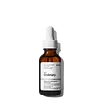What's inside
What's inside
 Key Ingredients
Key Ingredients

 Benefits
Benefits

 Concerns
Concerns

No concerns
 Ingredients Side-by-side
Ingredients Side-by-side

Water
Skin ConditioningDimethicone
EmollientGlycerin
HumectantButylene Glycol
HumectantNiacinamide
SmoothingDimethyl Isosorbide
SolventDimethicone/Vinyl Dimethicone Crosspolymer
Skin ConditioningHydroxyethyl Acrylate/Sodium Acryloyldimethyl Taurate Copolymer
Emulsion StabilisingGlycine Soja Oil
EmollientLauroyl Lysine
Skin ConditioningPEG-8
HumectantPhenoxyethanol
PreservativeSqualane
EmollientGlycine Soja Seed Extract
Skin ConditioningPolysorbate 60
EmulsifyingAcrylates/C10-30 Alkyl Acrylate Crosspolymer
Emulsion StabilisingCaprylyl Glycol
EmollientPolyurethane Crosspolymer-1
Chlorphenesin
AntimicrobialHydroxypinacolone Retinoate
Skin ConditioningPolysorbate 20
EmulsifyingSodium Hydroxide
BufferingDisodium EDTA
Lactic Acid
BufferingRetinol
Skin ConditioningOlive Glycerides
EmulsifyingSorbitan Isostearate
EmulsifyingCeramide NP
Skin ConditioningSodium Hyaluronate
HumectantPhenethyl Alcohol
MaskingGlyceryl Caprylate
EmollientPhenylpropanol
MaskingOpuntia Ficus-Indica Stem Extract
Skin ConditioningOpuntia Ficus-Indica Callus Culture Extract
AntioxidantWater, Dimethicone, Glycerin, Butylene Glycol, Niacinamide, Dimethyl Isosorbide, Dimethicone/Vinyl Dimethicone Crosspolymer, Hydroxyethyl Acrylate/Sodium Acryloyldimethyl Taurate Copolymer, Glycine Soja Oil, Lauroyl Lysine, PEG-8, Phenoxyethanol, Squalane, Glycine Soja Seed Extract, Polysorbate 60, Acrylates/C10-30 Alkyl Acrylate Crosspolymer, Caprylyl Glycol, Polyurethane Crosspolymer-1, Chlorphenesin, Hydroxypinacolone Retinoate, Polysorbate 20, Sodium Hydroxide, Disodium EDTA, Lactic Acid, Retinol, Olive Glycerides, Sorbitan Isostearate, Ceramide NP, Sodium Hyaluronate, Phenethyl Alcohol, Glyceryl Caprylate, Phenylpropanol, Opuntia Ficus-Indica Stem Extract, Opuntia Ficus-Indica Callus Culture Extract
 Reviews
Reviews

Ingredients Explained
These ingredients are found in both products.
Ingredients higher up in an ingredient list are typically present in a larger amount.
Dimethyl Isosorbide is a low-irritation solvent that helps deliver actives into your skin. It is created from glucose.
Research shows how well this ingredient works depends on the active and formulation rather than the concentration alone. This means adding more Dimethyl Isosorbide does not guarantee better penetration of ingredients into the skin.
This ingredient is a retinoid. It usually goes by a more common name: "Granactive".
Hydroxypinacolone Retinoate (HPR) belongs to the class of retinoids that also includes retinol and tretinoin.
Retinoids have been proven to:
So what is the difference between all the retinoids?
Most retinoids need to go through a conversion line to become effective on skin. The ending product is retinoic acid. Retinoic acid is AKA tretinoin.
HPR is an ester of tretinoin. Emerging studies suggest HPR to have an added benefit that other retinoids don't have: Low irritation.
A study from 2021 found HPR to have the greatest stability when exposed to light and temperature out of all the commercial retinoids.
A note about naming:
The name "Granactive" is the trade name and the name most commonly used on packages.
Granactive is the name of the mixture - about 90% solvent and 10% HPR. A product with 5% granactive has 0.5% HPR.
Learn more about Hydroxypinacolone RetinoateSqualane is an emollient that helps the skin hold onto moisture. It's an oily liquid that occurs naturally in certain types of fish and plant oils.
Because squalane boosts hydration in the skin, it also comes with plenty of benefits: it is an antioxidant and can help fight free radicals and skin damage. Squalane is also found to have a detoxifying effect when applied.
Squalane comes from squalene, which occurs naturally within the sebum of our skin. It is one of the oils our skin produces to keep itself hydrated. Squalane is the hydrogenated version of squalene and has a longer shelf life.
Research shows that squalane is non-irritating (even at 100% concentration).
In general, it's a fantastic ingredient. It does a great job at hydrating the skin, and it's suitable for those with sensitive skin.
The source of squalane may impact malassezia / fungal acne. This is because olive oil derived squalane can contain impurities such as fatty acids and plant waxes. Sugarcane derived squalane is recommended for anyone with malassezia concerns.
Is squalane vegan?
This depends on the source. Squalane can be derived from both plants and animals. Most squalane used in skincare comes from plants.
Please note: the source of squalane is only known if disclosed by the brand. We recommend reaching out to the brand if you have any questions about their squalane.
Read more about squalene with an "e".
Is squalane an oil?
Squalane is often called an oil, but it’s technically not; it’s a hydrocarbon, meaning it’s only made of carbon and hydrogen, unlike true oils which are triglycerides made of fatty acids and glycerol.
The term “oil-free” isn’t regulated, so companies can define it however they want. Some exclude all oils, while others just avoid mineral oil or comedogenic oils.
While some people avoid oils thinking they cause breakouts, the right kind of oil (or oil-like ingredient like squalane) can actually help balance and hydrate your skin. It’s worth testing out simple oils or squalane to see what works best for your skin.
Learn more about Squalane